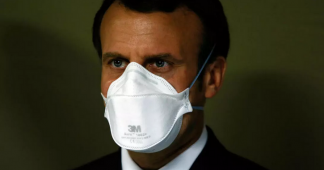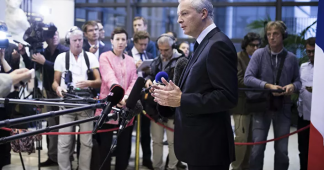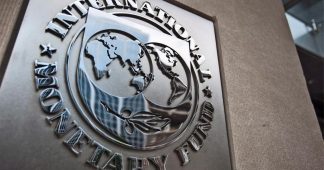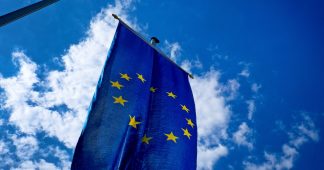Germany’s chancellor Angela Merkel is desparately trying to convince the governments of EU member states to agree on the EU Recovery Plan. So far, Merkel is very concerned that the EU Council scheduled for 17 July 2020 and onwards might not be be able to deliver on the package proposed by the European Commission. EU Council President Charles Michel put forward a ‘compromise proposal’ on all this, with slight changes to the original plan. It remains to be seen whether a compromise can be agreed at all. And if so, analyzing its content is essential …
Concerning the EU’s reaction to the expected economic downturn linked to the Covid-19 pandemic ‘Great Lockdown’, first let’s have a look at the ‘bigger picture’.
Global recession, EU most hit, EU economies drifting further apart
The International Monetary Fund (IMF) in its recent ‘World Economic Outlook’ (June 2020) predicts that the European Union will be most hit by the economic crisis: a loss of 10.2 percent of real GDP in 2020 for the euro-zone, compared to 8 percent for the U.S., 5.8 percent for Japan, but still 1 percent economic growth projected for China. Forecasts of the World Bank and the OECD go in the same direction.
Looking at the EU, member states economies are further drifting apart. To give just a few examples from the IMF projections: France, Italy, Spain may expect GDP losses in 2020 well above 12 percent, Germany might be better off with losses of about 7.8 percent. The same about unemployment rates, which are expected to be much higher in Spain, Italy and France compared to Germany, the Netherlands, Sweden and Denmark. Gross Government Debt is expected to rise in 2020 to 125.7 percent of GDP in France, to 123.8 percent in Spain, to 166.1 percent in Italy – but only to 77.2 percent in Germany.
The European Commission recently published its summer 2020 economic forecast, which is more optimistic than those by the OECD and the IMF. But less optimistic than its earlier ‘spring forecast’. On the global and European economic outlook, these institutions generally agree: ‘A deeper recession with wider divergences’ (EU Commission on Europe), ‘A crisis like no other, an uncertain recovery’ (IMF). All those projections predict that there will be a ‘V-curve’ of economic activity (downturn in 2020 followed by a strong upturn in 2021). Even mainstream economists have doubts about this hypothesis. Heterodox economists such as Michel Husson suggest that the ‘recovery’ will look more like the famous ‘Nike swoosh’ …
Be this as it may – let’s have look at what the EU has done so far to counter the expected recession and what is on the table for ‘compromising’ on its Recovery Plan.
The ECB’s reaction
Firstly, the European Central Bank (ECB) reacted quickly to the prospect of an economic downturn. Already in March 2020, it adopted its new Pandemic Emergency Purchase Programme (PEPP), massively buying up EU government bonds (to keep interest rates on these low), and also private and public sector securities. In March 2020 the ECB’s envelope for this amounted to €750 billion. In June 2020 the ECB expanded PEPP to a total of €1,350 billion. This is something, indeed. Even many ‘progressive’ macro-economists argue, that with this move the ECB is doing the right thing by protecting also economically weak member states from otherwise rising spreads for their bonds on the financial markets.
However, the ‘progressive’ economists in my view seem to have forgotten that the ECB is an ultra-independent Central Bank by any standards. Remember how the ECB reacted after 2010 (when at least the German economy had recovered from the financial crisis 2007/9)?
Ousting Giorgos Papandreou in Greece (to be followed by a ‘technocratic expert government’ led by Loukas Papadimos in 2011), ousting Silvio Berlusconi in Italy (same procedure, Mario Monti’s ‘expert government’ installed in November 2011). All this by demanding neo-liberal structural reforms – otherwise the ECB would not further support the purchase of Greek or Italian government bonds. Serge Halimi (LMD) rightly characterized these moves as imposing ‘civil juntas’ from above (the EU level, commonly orchestrated by Berlin, the EU Commission and the ECB). How the ECB in 2015 brought the Syriza government in Greece to its knees – providing no liquidity any more to the Central Bank of Greece, pushing the country after the OXI referendum to economic collapse – that is well known.
Yes, for now the ECB might follow a more ‘benign’ approach as regards the EU South in comparison to this past. Currently: from the governments of Portugal, Italy, Spain, Greece or Cyprus, there is no major challenge to be expected against the fundamental EU rules. But the EU’s and the ECB’s benign attitude towards them might change (if the German economy should come back more strongly out of the recession).
Greenpeace Europe pointed out, that the ECB’s PEPP from March to May 2020 was purchasing corporate bonds to a great extent from the fossil fuels industry. Not so compatible with the ‘Green Deal’ as propagated by Commission President von der Leyen … ‘Greening finance’ – a lot needs to be discussed about this (also whether finance from private institutional investors might be helpful in achieving an environmental-social just transition).
The EU’s already established ‘safety net’ as a response to the Corona crisis
There is the €240 billion credit line from the European Stability Mechanism (ESM) for eurozone members. It offers cheap loans for 10 years amounting to maximum 2% of GDP of each country to cover pandemic-related healthcare costs. The countries most affected by the pandemic (such as Italy, Spain, France) did not apply for such ESM loans. Why? Applying for an ESM loan could signal that the country has weak public finances (‘stigma effect’), possibly driving up spreads on respective government bonds. After the experience with the Troika, there are also fears about ESM conditionalities linked to the loans. So this is a credit line not being used, because of its very construction based on loans and uncertainty on the conditionalies…
There is the €100 billion temporary Support to mitigate Unemployment Risks in an Emergency (SURE) for all EU countries. Simply put, this is the promised EU-support to assist with financing short-term-work schemes in the member states to cushion the effects of the crisis on employment. Highly praised by von der Leyen as EU-solidarity for the poorer countries. However, most member states (and not only Germany) have such national schemes already in place. For an informative overview, see the report by Torsten Müller and Thorsten Schulten on this from the European Trade Union Institute (ETUI) here.
So far it seems that Romania is the first country to ask for a €5 billion loan from that facility. The great majority of member states did not apply for SURE funding. Why? As the Bruegel think tank earlier pointed out, “SURE’s effect on public finances will be very marginal as the programme is too small (€100 billion) to lead to significant savings in interest costs.” Same problem: based on loans, this is not attractive. Also note that the Commission having received an application for SURE funding, it will ‘consult the member state to define the terms of the loan, based on an evaluation of the increase in public expenditure’. If the increase of public expenditure is considered too high by the Commission, perhaps less ‘generous’ terms for the loan follow from that?
Finally there is the €200 billion programme of the European Investment Bank (EIB) to support troubled small and medium-sized enterprises (SME’s) across the EU with extra liquidity. According to the Bruegel think tank, this instrument would not significantly alleviate the fiscal burden of high-public debt countries. This instrument is conceptualized to be highly ‘leveraged’: the EIB has only €25 billion in real money at its disposal for this, and the hope is that with that amount it can attract a lot of private finance to reach the €200 billion projected. Already, the EIB demands more money and staff to handle the projects that the European Commission is planning as part of the ‘€750 billion’ recovery plan.
The €540 billion monies of these instruments so far mainly remain untapped because of its faulty loans-based construction.
Michel’s compromise proposals
Council President Charles Michel now expects member state governments to agree on the Multiannual Financial Framework (MFF) for the EU budget for the period 2021 – 2027 and on the Next Generation EU/Recovery Fund proposal. As the EU wants to become a global geopolitical player with improved military capabilities (‘Defense Union’), the MFF contains explicit budget lines on ‘security’ and ‘defense’ (officially about €14 billion for both). The MFF does not strive for a a more fundamental reform of the EU’s budget. For example, instead of streamlining the Common Agricultural Policy entirely towards organic farming and sustainable development, the EU just set a target of 25% of EU farms being organic by 2030 in its Farm to Fork Strategy. However, payments to intensive farming that harm the environment have been largely left untouched.
As there is no trade agreement with the UK after Brexit in sight, Michel proposes a €5 billion ‘Brexit Adjustment Reserve’ to counter adverse effects from the expected ‘No-deal Brexit’ for member states and sectors most affected by this. The likely beneficaries of that are Ireland, but also some regions and sectors in France, the Netherlands and Germany.
Concerning the overall amounts for the MFF, in 2018 a total of €1134.6 billion was proposed. In February 2020 this was reduced to €1100 billion. In order to get the opposition of the ‘frugal four’ member states (Austria, Netherlands, Denmark and Sweden) on board, Michel now proposes to cut the MFF down to a total of €1074 billion, and to introduce a plastic-waste based levy, a carbon border adjustment mechanism and digital levy. With financial resources created from these EU-levies, an earlier repayment of Commission debts on Next Generation EU is offered (starting in 2026 instead of 2028). Whether all of the frugal four will be convinced by these slight changes, remains to be seen. In any case the EU Council will need to reach unanimity to get the whole package (MFF, Recovery programme) adopted.
The opaque Recovery and Resilience Facility
On Next Generation EU and the recovery programme, the mysterious Recovery and Resilience Facility (RRF, €560 billion) is at its core. Michel proposes firstly to allocate €217 billion from this in grants in 2021-2022, and for 2023 €93 billion in loans (the latter to be invested in projects concerning the ‘green and digital transitions’ in EU speak). This seems to be less than originally projected by the Commission: € 310 billion in grants, €250 billion in loans. Whether the loans component of the RRF will be used by member states, remains to be seen. Considering the experience with the earlier rescue packages (ESM, SURE, EIB), I am skeptical. Anyhow, much ‘financial wizardry’ is behind the EU’s plans – as the proposals are always changing and a ‘moving target’. Quite a number of its components are based on ‘leveraging’ EU-monies to multi-fold by ‘attracting private finance’. So it is complicated to find out what is ‘real’ about them and what is not …
The criteria for the ‘allocation key’ of the RRF is designed as considering the unemployment rate 2015-2019 for the grants, the overall drop in GDP in 2020/21 for the loans, and inverse GDP per capita and population share for both. On the unemployment criteria, the Bruegel think tank in my view rightly points out that looking at 2015-2019 data is not very helpful, as unemployment dynamics now might be different: “As many people who lost their jobs have not registered as unemployed, unemployment data paints only a partial picture of labour market losses. Employment figures would be more accurate.”
The RRF is designed as a ‘firebrigade’ measure until 2024. The conception is this: member states should submit annual ‘national recovery and resilience plans’, to be assessed and approved by the Council based on qualified majority voting. Then the EU Commission would take over on decisions about the release of such funds, linked to its ‘European Semester’ recommendations. Note that the European Parliament (EP) would have no say about these procedures and the allocation of monies from the RRF. The Council (inter-governmental carpet baggering) would be in the lead, and the Commission would provide the ‘fine tuning’ on the Councils decisions.
RRF and the European Semester
Already with the introduction of the European Semester process, the ‘extreme centre’ majority of the EP had no intention at all to be included in decision making on that. At that time it was more interested in expanding the powers of the Commission. So that possible sanctions proposed by the Commission against member states not complying with its recommendations on the European Semester could be triggered ‘automatically’ and only be vetoed by the Council by ‘reverse qualified majority voting’. What this means: even if more than half of all EU member states would disagree with a certain recommendation or sanction proposed by the Commission, it would be adopted and would have to be implemented nevertheless. This had been enshrined in the respective EU-legislation on the pressure from the EP (six-pack & two pack). But so far (fortunately) it was not being used by the ‘political’ Juncker Commission that took office after those decisions were made. For further reading on the European Semester, its past recommendations 2011 – 2018 and so on, check the excellent overview by Emma Clancy on this here.
Other controversial issues
Finally, also a number of controversies apart from the ones already told remain between member state’s governments: the issues of ‘front-loading’, the rebates, and on linking structural funds monies to compliance with EU values about democracy and the rule of law.
Merkel, Macron and governments of the EU South passionately call for an early agreement on the whole package, so that EU monies should flow as soon as possible to those member states ‘most in need’. However, due to the administrative processes, programme design and approval procedures enshrined in the existing EU-budget methodology, actual pay-outs will not be very much front-loaded now but spread over a number of years. “The Commission expects that barely 24.9% of the total new firepower for grants would be spent in 2020-2022, when the recovery needs will be greatest” – so the analysis by Zoltan Darvas. This means that about 75 percent of Next Generation EU payments will have to wait until 2023 – a timeline in which the EU-Commission, the IMF and others expect that a strong recovery is already under way. Amazing timing – isn’t it?
Readers might remember Margaret Thatcher’s famous speech to the EU of earlier times: “I want my money back”. She successfully pressed the EU in conceding a rebate to the UK, as she argued that the UK’s net payer status to the EU budget would be too demanding. Originally, according to the 1984 Fontainebleau Summit’s statement on this, “any Member State sustaining a budgetary burden which is excessive in relation to its relative prosperity may benefit from a correction at the appropriate time“. From this, one should expect that rebates are reserved for the poorer EU countries. However, following in the footsteps of Thatcher, it are now the rich ‘frugal four’ and Germany having pushed through rebates for their respective countries. And this shall remain so, according to Michel’s compromise proposal. Also amazing, with respect to the newly found ‘spirit of solidarity’ within the EU.
Imposing compliance to EU standards on democracy and the rule of law conditional on receiving structural funds monies from the EU budget has been a long-standing demand by the EU Commission, France and Germany. Targeting in particular Poland and Hungary. Merkel, however, now wants to get an agreement on the MFF and the Recovery Programme first, and come back to this issue later on. Hungary’s President Viktor Orban is very much uncompromising towards such plans. On that issue, it is very likely that the EU remains a ‘toothless tiger’. Merkel and Macron simply need the Eastern European governments on board to get a compromise on the Recovery package approved.
Concluding remarks
In March 2020 the ECB suggested that a fiscal intervention of €1.5 trillion would be needed in the EU already in 2020 to counter the economic effects of the Covid pandemic. Compare this to what has been done and what is on the table now. I agree very much with the Bruegel think tank’s earlier viewpoint: “The overall measures announced remain below what the dire economic situation would necessitate.” Let’s see whether and which ‘compromise’ may be agreed upon by the EU Council. Yes, the EP will also have to approve a possibly emerging ‘compromise’. But the EP is no match in this game – its historical record is simply, that in a situation when the very existence of the EU might be at stake, it will follow the Council (with maybe some critical comments attached).
Concerning Germany, its government is also working along another route: reviving business and trade with China. This is by far Germany’s biggest trading partner. The rebound of the German economy after the 2007/9 financial crisis was very much based on investing in and trading with China. For German capital, to maintain its economic dominance of the EU, and also to recover its ‘global economic outreach’ are two complementary sides of the same coin: to sustain the survival of its export-led growth model. No illusions about that – whatever the official rhetoric about ‘European Solidarity’.











